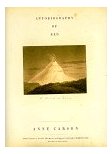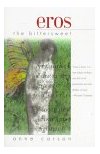|
Contents » Cover | ||
|
Reviews
Only an audacious poet such as classicist Anne Carson could create a readable, entertaining, instructive, and philosophic postmodern fable of obsessive love from its prerequisite states of despair, hate, ecstasy, violence, loss, and ambivalence. She goes one step further by placing this retelling of the ancient Greek Stesichoros' Geryoneis ("Tale of Geryon") in the present. Herakles becomes, in Carson's version, not the righteous hero of myth who murders the monster Geryon for his magic red cattle of Erytheia ("The Red Place"), but a glittering hunk who steals Geryon's awkwardly tender heart and then departs. Geryon remains, with his red coloring and red wings, dying a little every day, pouring his insecurities and unfulfilled desires into the black hole of a camera lens. Already in erotic shock from sexual abuse by his older brother, Geryon begins to make a comforting world through photography's single eye and focused light. He manages to get by—just get by—for when he met Herakles "the kingdoms of his life all shifted down a few notches." Geryon stumbles upon Herakles and his new love years later on the very day he determines "not / to become one of those people / who think of nothing but their stores of pain" and on "a day when (his) face is puffy!" Only at this reconnecting does the volcano brooding in Geryon's psyche come to life, and Geryon finds his true self. Carson has created a profoundly moving and sad meditation on self-denial and self-revelation through the lens of Eros—its slow rapidity in Time, possessive and dispossessive aches, violence and vibrating tendernesses, absence and ever-present soul-gnawing. Lava, like these states of consciousness, engulfs this tale, becoming representative of Geryon's soul urging itself forward. How appropriate that Red Geryon internalizes his rage and endless longing, his eros (Greek for "desire for that which is missing"), and transforms it through photography, for Autobiography of Red is cinematic, down to staged interviews with Stesichoros and light-hearted critical "essays" which introduce and close the literal (yet eerie and lovely) translation of Geryon's story and Carson's poem-novel. Carson writes like no other writer—bitter plain language full of matter-of-fact presumptions of mind and heart which, as we know, often misguide without Soul as compass. Her language recalls Dickinson, Monique Wittig, and Stein. She reinvigorates its sinews, she brightens its colors and tones. This scene tells of Geryon's stereotypically anguished attachment to his mother:
Don't pick at that Geryon you'll get infected. Herakles, purely physical and unreflective male, seems the answer to Geryon's dreams. Confusing his red wings and red complexion with lack of personal power he imagines that Herakles's vital flesh can complete him: "It was not the fear of ridicule, / to which everyday life as a winged red person had accommodated Geryon early in life, / but this blank desertion of his own mind / that threw him into despair." With this book Anne Carson has become our greatest commentator on the Classics's pertinence in modern life. Here, and in Eros the Bittersweet, she dissects our soulless flesh-hunger and finds eros, the teacher: "for desire is a movement that carries yearning hearts from over here to over there, launching the mind on a story . . . . In the city without desire such flights are unimaginable. Wings are kept clipped. The known and the unknown learn to align themselves one behind the other so that . . . they seem to be one and the same, . . . To reach for something else than the fact will carry you beyond this city, . . . It is a high-risk proposition, as Sokrates saw quite clearly, to reach for the difference between the known and the unknown." Carson imagines for Geryon, for literature, poetry, and for us, a city in which erotic experience must "re-create in you a certain action of the mind and heart—the action of reaching out toward a meaning not yet known. It is a reach that never quite arrives, bittersweet." The monsters, the daemons, we carry inside—not the ones we believe we are—if allowed to speak show us a way to make artful lives from inarticulate suffering. In another essay published in the Canadian magazine Brick, "Simonides and the Art of Negative Attention," Carson celebrates the value of no-saying, the melancholic embrace of negation, the via negativa, which opens up the cosmos, confirming that no experience is not positive (as she or Simonides would put it), for all experience brings transformation to the Aware. Finding an artful way to speak to an audience reared on MTV and dysfunction, this book rings with the kind of off-handed wisdom one finds in comic book heroes, and with the subtle revelations found in obscure sacred books. That a queer monster who hides his red wings under his jacket should be bearer of such news proves art does re-invigorate itself, and that genius finds art outside of time and traditional metaphor. Autobiography of Red, Homeric in its originality, is yet, almost Homer Simspon in cast—but a Simpson with a difference—fed by molten streams of the Greek philosophers and poets, and of a world in which Gods and mortals love and war together. Eros the Bittersweet, worthy of Emerson, provides sign-posts for the journey. Carson, our new Emerson, haunts us with her troubling beautiful ambiguities and contradictions—enlivening and uplifting us thereby.
|
||||||||

